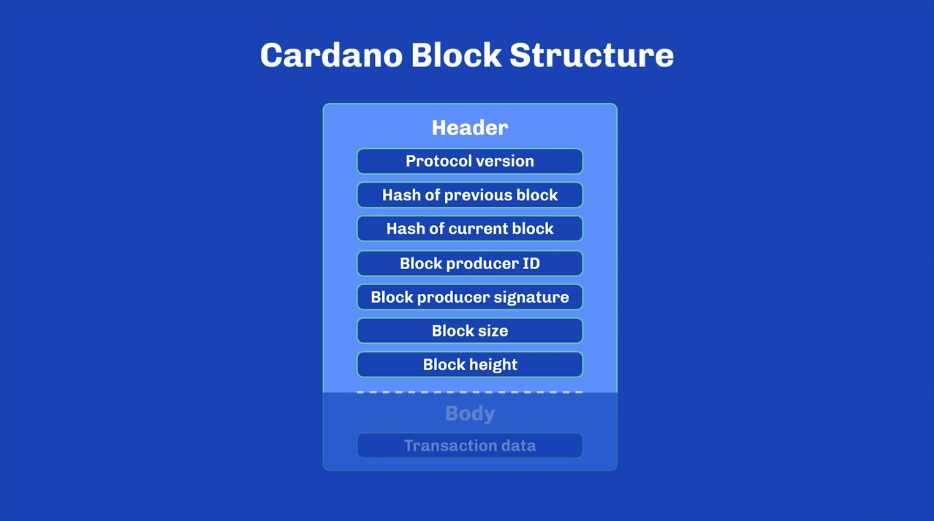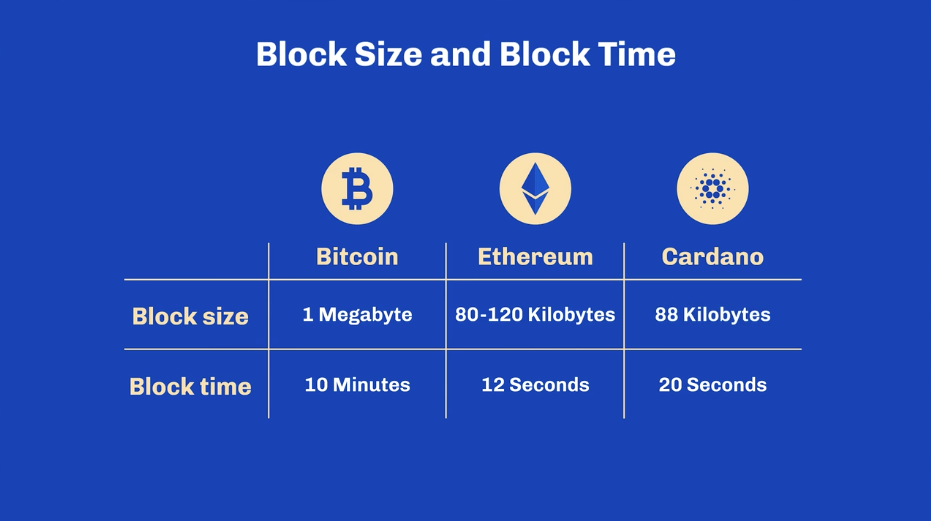Cardano’s block structure refers to the organization and format of data within a block in the Cardano blockchain. Each block contains several key components, including transaction data, metadata, and cryptographic proofs, which collectively enable the secure and verifiable operation of the blockchain.
Cardano’s block structure is designed to be efficient and scalable, leveraging its Ouroboros Proof-of-Stake (PoS) consensus mechanism and Extended Unspent Transaction Output (eUTXO) model.

Key Components of Cardano’s Block Structure
- Block Header: The block header contains metadata about the block and is essential for linking blocks together to form the blockchain. Key elements include:
- Block number: The sequential number of the block in the chain.
- Slot number: Refers to the specific time slot during which the block was created. Each epoch (a longer period) is divided into slots.
- Previous block hash: A cryptographic hash of the previous block’s header, ensuring that the blocks are linked in a chain.
- Merkle root: A root hash that summarizes all transactions in the block, enabling efficient and secure verification of transaction integrity.
- VRF proof: A proof generated by the Verifiable Random Function (VRF), which confirms that the stake pool selected to create the block was chosen fairly and randomly.
- Signature: A digital signature from the block producer (slot leader) that confirms the authenticity of the block.
- Transactions: Cardano uses the Extended Unspent Transaction Output (eUTXO) model, where transactions consist of inputs and outputs. Each input references a previous UTxO (an unspent output from a prior transaction), and each output creates a new UTxO that can be spent in future transactions. A block typically contains:
- Transaction inputs: References to previous UTxOs being spent in the current transaction.
- Transaction outputs: New UTxOs generated by the transaction, which include addresses and the amount of ADA or tokens being transferred.
- Transaction metadata: Optional data associated with a transaction, used for additional information, such as smart contract execution or attaching details for on-chain governance.
- Smart Contracts and Plutus Scripts:
- Plutus scripts: Blocks may also include Plutus smart contract scripts, which are code snippets executed on the Cardano blockchain. These scripts define the conditions under which a particular UTxO can be spent.
- Datum: Information provided as part of the smart contract input that determines how the contract logic is executed.
- Redeemer: Data used when consuming an output, ensuring the execution of specific conditions in the smart contract.
- Block Body: The block body contains the actual transactions that occurred within the block. Each transaction in Cardano is represented using the eUTxO model, and transactions are validated against the rules of the blockchain to ensure correctness. In addition to transactions, the block body includes:
- Transaction fees: Fees paid by users for processing their transactions. These fees are distributed to block producers as rewards.
- Native assets: Cardano supports native tokens, which are also included in transactions. Native assets can represent any custom tokens created on Cardano.
- Stake Distribution Information: Blocks in Cardano also carry information about stake distribution, which is critical for the PoS consensus mechanism. This data ensures that the selection of slot leaders (block producers) is done based on the proportion of ADA staked in various pools.
- Block Size: The size of a Cardano block is currently capped, with the size limit increasing over time to support scalability. As of now, Cardano’s block size is around 88 KB (subject to change based on network upgrades). This limit helps balance throughput with decentralization and scalability.
- Slot Leaders (Block Producers): In each block, the block producer, also known as the slot leader, is the entity responsible for validating and creating the block. The slot leader is selected based on a random process using the VRF mechanism and the stake distribution across pools.

Ouroboros and Block Structure
- Cardano’s blocks are created according to its Ouroboros Proof-of-Stake (PoS) consensus algorithm, which divides time into epochs (lasting around 5 days), with each epoch further divided into slots.
- During each slot, a slot leader is selected randomly from the pool of stake holders to produce a block. If no slot leader produces a block in a given slot, the system moves to the next slot without creating a block, ensuring security and efficiency.
Special Block Types
- Genesis Block:
- The first block in the Cardano blockchain, which initializes the chain and sets the foundational parameters of the network.
- Epoch Boundary Blocks:
- These blocks contain special information about staking and delegation at the end of each epoch, including the rewards distribution for delegators and stake pools.
Block Propagation and Validation
Once a block is produced by a slot leader, it is propagated through the network to all other nodes. Each node validates the block by checking the correctness of the transactions and ensuring the block adheres to the network’s rules, including the validity of the VRF proof and the digital signatures. Once validated, the block is added to the local copy of the blockchain.
Summary
Cardano’s block structure is designed to be secure, scalable, and flexible, leveraging its eUTXO model, smart contracts via Plutus, and its unique Ouroboros Proof-of-Stake consensus mechanism. Each block consists of a header, transactions, metadata, and cryptographic proofs, ensuring a high level of security, transparency, and efficiency in processing transactions and validating blocks.

Leave a Reply